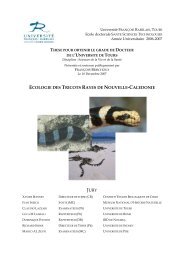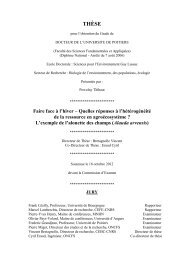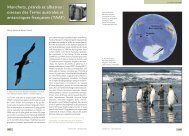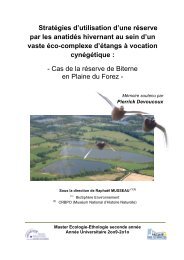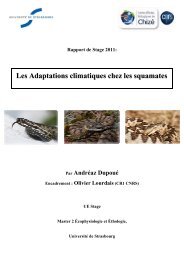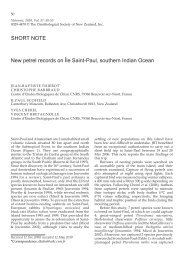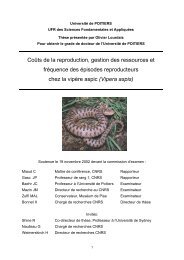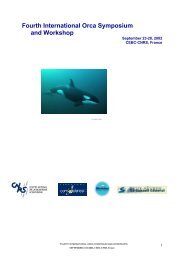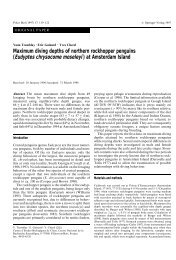Forçage environnemental et prédateurs marins ... - Cebc - CNRS
Forçage environnemental et prédateurs marins ... - Cebc - CNRS
Forçage environnemental et prédateurs marins ... - Cebc - CNRS
Create successful ePaper yourself
Turn your PDF publications into a flip-book with our unique Google optimized e-Paper software.
Ecology, 86(3), 2005, pp. 682–692<br />
2005 by the Ecological Soci<strong>et</strong>y of America<br />
ENVIRONMENTAL CONDITIONS AND BREEDING EXPERIENCE AFFECT<br />
COSTS OF REPRODUCTION IN BLUE PETRELS<br />
CHRISTOPHE BARBRAUD 1 AND HENRI WEIMERSKIRCH<br />
Centre d’Etudes Biologiques de Chizé, <strong>CNRS</strong> UPR 1934, 79360 Villiers en Bois, France<br />
Abstract. Using data from a 17-year study of individually marked Blue P<strong>et</strong>rels, we<br />
examined how survival and breeding probability varied with experience and breeding status,<br />
and looked for costs of first reproduction, taking into account environmental and individual<br />
variability. Using multistate capture–recapture models with four states (inexperienced nonbreeders,<br />
first-time breeders, experienced breeders, and experienced nonbreeders), we found<br />
that first-time breeders had a lower probability of surviving and breeding in the next year<br />
than experienced breeders. Survival of first-time breeders was lower than that of inexperienced<br />
nonbreeders, indicating a cost of first reproduction. Survival of inexperienced individuals<br />
(both breeders and nonbreeders), but not of experienced ones, was negatively<br />
affected by poor environmental oceanographic conditions. The costs of reproduction for<br />
first-time breeders were particularly marked during harsh weather conditions. Survival and<br />
the probability of breeding in the next year for experienced birds were higher for breeders<br />
than for nonbreeders. Similarly, the probability of breeding in the next year for first-time<br />
breeders was higher than for inexperienced nonbreeders. This suggests h<strong>et</strong>erogeneity in<br />
quality among individuals. Experienced breeders had a higher body condition than firsttime<br />
breeders and nonbreeders. Body condition did not affect the probability of surviving<br />
or breeding in the next year. These results can be interpr<strong>et</strong>ed in the light of a change in<br />
the proportion of individuals with different survival (selection hypothesis: low-quality<br />
individuals die sooner). The inferiority of first-time breeders may be linked to a higher<br />
proportion of lower-quality individuals in younger age classes. First reproduction may act<br />
as a filter, selecting individuals of higher quality. Sea surface height, reflecting food availability,<br />
is probably a key selective agent.<br />
Key words: Blue P<strong>et</strong>rel; body condition; breeding probability; environmental stochasticity; experience;<br />
Halobaena caerulea; multistate capture–recapture models; nonbreeding; reproductive cost;<br />
sea surface height; survival probability.<br />
INTRODUCTION<br />
How do animals balance their investment in offspring<br />
against their own chances to survive and reproduce<br />
in the future? This life history trade-off, referred<br />
to as the cost of reproduction (Williams 1966), holds<br />
a central place in life history theory (Roff 1992, Stearns<br />
1992, McNamara and Houston 1996). Because individuals<br />
can only acquire a limited amount of energy,<br />
reproduction and survival, as well as current and future<br />
reproduction, are considered as functions comp<strong>et</strong>ing<br />
for the same resources. In this framework individuals<br />
may optimize life history decisions. If the reproductive<br />
effort in one year leads to a loss in future reproductive<br />
output through decreased adult survival or reduced fecundity,<br />
then the optimal effort in the current season<br />
is less than the effort that would maximize the number<br />
of offspring produced in that season (Charnov and<br />
Krebs 1974, Goodman 1974).<br />
There are two major questions linked to the assessment<br />
of the costs of reproduction. (1) Does present<br />
Manuscript received 9 January 2004; revised 19 July 2004;<br />
accepted 23 August 2004. Corresponding Editor: J. R. Sauer.<br />
1 E-mail: barbraud@cebc.cnrs.fr<br />
682<br />
reproductive effort have an adverse effect on future life<br />
history (survival or future reproduction)? (2) Are the<br />
costs of reproduction the same for the different phenotypes<br />
of the population? Theor<strong>et</strong>ically, because nonbreeders<br />
avoid potential costs of reproduction, they are<br />
expected to have a higher survival and higher future<br />
breeding probability at the next occasion than breeders<br />
(prudent parent hypothesis; Goodman [1974], Drent<br />
and Daan [1980]). Secondly, several studies have<br />
shown an increase in survival and reproductive output<br />
with age, particularly after first reproduction, with firsttime<br />
breeders having a lower probability of breeding<br />
successfully (Newton 1986, Reid <strong>et</strong> al. 2003), a higher<br />
probability of nonbreeding in the following year (Coulson<br />
and Thomas 1985, Weimerskirch 1990, Wooller <strong>et</strong><br />
al. 1990, Viallefont <strong>et</strong> al. 1995a, b), and a lower survival<br />
or r<strong>et</strong>urn rate than experienced individuals<br />
(Wooller <strong>et</strong> al. 1989, Promislow 1991, Chastel <strong>et</strong> al.<br />
1995a, Clutton-Brock <strong>et</strong> al. 1996, Reid <strong>et</strong> al. 2003).<br />
However, at least two kinds of factors are likely to<br />
confound the measurement of the costs of reproduction<br />
in the wild. First, phenotypic h<strong>et</strong>erogeneity can mask<br />
or exacerbate individual allocation patterns when<br />
trends are averaged across a population (h<strong>et</strong>erogeneity



